Deja' vu, Spike Rally in Japanese Yen Spooks Global Financial Markets
Stock-Markets / Financial Crash Jul 26, 2007 - 02:32 PM GMTBy: Gary_Dorsch
Perhaps the most important market in the world today is the vast network of foreign currencies, where total trading volume, including derivatives and futures, average around $2.9 trillion a day. This is ten times the size of the combined daily turnover on all the world's equity markets. And as world's economies have become increasingly integrated, so have the foreign exchange and global capital markets.
And the size of the foreign exchange market is mushrooming each year. FX trading increased by 38% between April 2005 and April 2006 and has more than doubled since 2001. That's not surprising, since 18 of the top-20 central banks around the world are tolerating double-digit growth of their money supply. Therefore, fluctuations in the foreign exchange market are bound to become more violent.
But the foreign exchange market is only one piece, albeit a very important one, of a bigger puzzle. Turnover of interest rate, currency and stock index derivative contracts rose 24% to a mind boggling $533 trillion in the first quarter versus the previous quarter, underscoring the enormous leverage in the global markets. Thus, any major unexpected event can touch off a panicky and violent market reaction.
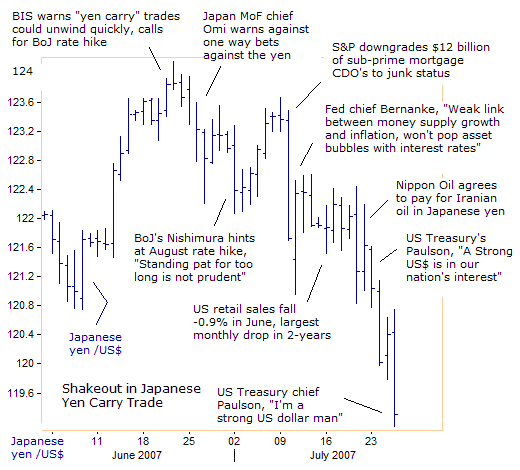
But it all starts with the foreign exchange market, the first port of call, for global investing. Central bankers have several tools at their disposal to influence foreign exchange rates, including verbal “Jawboning” to the media, outright intervention in the spot or futures market, or adjustments to short-term interest rates. But managing the direction of foreign currencies becomes more daunting, as the global money supply mushrooms each year, attracting more speculators to the markets.
Among the Group of Seven central banks, which oversee two-thirds of the world economy, the Bank of Japan is the most interventionist, working hard each day to guide the value of the Japanese yen to target ranges. Because of this constant manipulation, United Arab Emirates central bank chief Sultan Nasser al-Suweidi has ruled out the yen as a possibility for investment for the kingdom's FX reserves.
“Even when you see Japanese trade transactions they are in US dollars. It's not a currency. It's very much controlled by the central bank of Japan and it's lost some of its confidence. I think yen is losing ground in favor of sterling. Sterling is getting more important,” al-Suweidi said in a prophetic vision in November 2006. Since then, sterling climbed 10% to 250-yen, it's highest in 16-years.
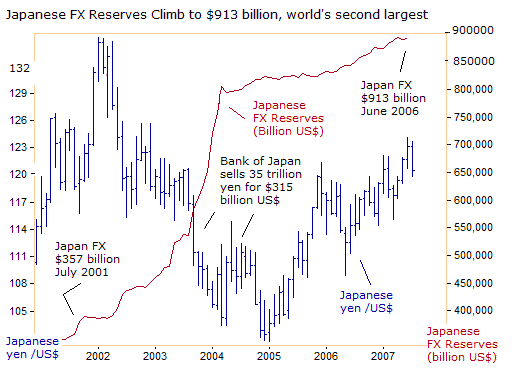
On Feb 9 th , US House Democrats complained to the US Treasury chief about the clandestine operations of Tokyo's financial warlords. “We believe that a weak yen is a reflection of Japanese government policy,” wrote Reps. Charles Rangel, Barney Franks, John Dingell and Sander Levin. “The Japanese government should be selling the massive reserves it has accumulated thereby changing the imbalances with the dollar and the Euro,” they said.
“The huge misalignment of the Japanese yen is giving Japanese auto manufacturers an unfair and undeserved trade advantage over US companies,” said Stephen Collins, President of the Automotive Trade Policy Council on July 24 th . “It's clear that the primary beneficiary of Japan's 25% to 30% undervalued yen is the Japanese auto industry, which is reaping a $4,000 to $10,000 yen subsidy for every vehicle it ships to the US,” Collins said.
But Treasury chief Paulson has always defended Tokyo's cheap yen policy. “I think the big point is the Japanese have a currency that is traded in an open and competitive marketplace based upon economic fundamentals,” he argued on Capitol Hill, on February 1 st . (Global Money Trends' special report for July 27 th , reveals an important clue on how to detect when Paulson's Plunge Protection Team, is operating in stock index futures.
The extent of Tokyo's intervention operations can be gauged by the size of its foreign exchange reserves. Tokyo controls a record $913 billion of foreign currency reserves, second only to China's $1.33 trillion, and mostly held in US Treasury securities. Japan's reserves ballooned after selling 35-trillion yen in 2003 and the first quarter of 2004, in exchange for 330 billion US dollars.
Toky o controls a record $913 billion of foreign currency reserves, mostly held in US Treasury securities. Japan's reserves ballooned after selling 35-trillion yen in 2003 and the first quarter of 2004, in exchange for 330 billion US dollars. Japan's FX reserves have continued to climb with a higher Euro, and a build-up of interest income from US bonds. The BoJ earned 3-trillion yen ($25 billion) of interest income last year, while paying 7.5 billion yen in interest on short-term T-bills, issued to finance past intervention, and is therefore, the world's largest “yen carry” trader.

Since its historic intervention effort in 2003-04, Tokyo has engineered a “cheap yen” policy, designed to boost Japanese exports, a key driver of the world's second largest economy. Japanese shipments to China and Hong Kong account for 32% of its exports today, with 18% sold to the US, 16% to Korea, and 5% to Europe. The “cheap yen” policy is showing tangible results, with overall Japanese exports climbing to 7.28 trillion yen ($60.5 billion) in June, up 16.2% from a year ago.
Not surprisingly, exports to China are growing the fastest, with the Chinese economy booming at an 11.9% annualized clip in the second quarter. Exports to Asia grew 15.8% from a year earlier to 3.54 trillion yen, rising for more than 5-years in a row, led by sales to China up 22.6% to 1.13 trillion yen. Europe bound exports rose 16.3% to 1.08 trillion yen, helped by the yen's weakness against the Euro.
Therefore, the Japanese yen is probably undervalued by 20% on a trade weighted basis. But the BoJ keeps the yen artificially low, by holding yen Libor interest rates at less than 1%, and by pumping 1.2 trillion yen into the banking system each month, thru the outright purchases of government bonds (JGB's). The BoJ justifies its ultra-low interest rate and “cheap yen” policy, by pointing to fraudulent statistics on inflation, conjured up by Japanese government apparatchniks.
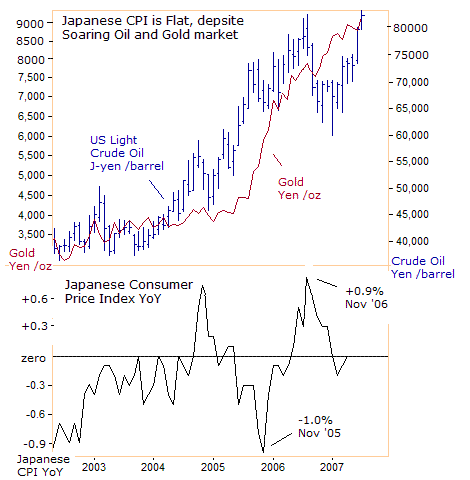
Tokyo argues that Japan is the only country in the world that is not experiencing any inflation at all, even at a time of sharply higher crude oil and food prices. Japan is the largest importer of food in the world, and the IMF states that food prices are 23% higher today than 18-months ago. Japanese oil importers are paying a record 9,250-yen per barrel for crude oil, double the price of two years ago.
Tokyo gold traders don't believe in the government's phony inflation numbers, and are bidding a record high of 82,500-yen per ounce for the yellow metal, up from 45,000-yen /oz in early 2005. If Tokyo told the truth about its inflation rate, global bond yields might be 100 basis points higher, and global stock markets might be 20% lower than today. The US Treasury surely understands this.
Tokyo's financial warlords weaken the yen in order to pump-up the export earnings of Japanese multinationals that dominate the Nikkei-225 index. Net exports, the difference between exports and imports, were the biggest contributor to growth in the first quarter, helping Japan's economy to expand at an annual 3.3% rate. Half of Japan's exports were traded in US dollars in the first half of 2007 compared with 38% in yen and 8.7% in euros. So a rising Euro and US dollar against the Japanese yen, inflates the earnings of Japanese multinationals that earn their income abroad.
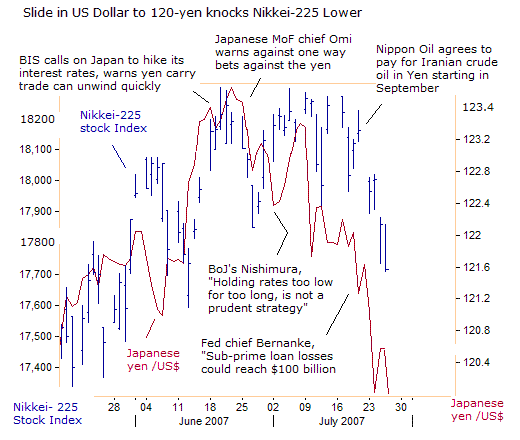
Of course, the process works in reverse, when the dollar and Euro tumble against the yen, lowering Japanese exporter revenue. Indeed, the Nikkei-225 Index topped out at 18,200, a six-year high, soon after June 24 th , when the Bank of Int'l Settlements warned that the yen could strengthen rapidly at a moment's notice. “There is clearly something anomalous in the ongoing decline in the external value of the yen. There seems to be a too firm conviction on the part of investors that the yen will not be allowed to strengthen in any significant way,” the BIS said.
“Investors might be better encouraged to consider the autumn of 1998, when the yen rose by more than 10% against the US dollar in the space of two days, inflicting sizeable losses on those involved in the carry trade business.” The size of “yen carry” trades is a hotly debated topic as no concrete official data is available, but estimates range from $150 billion to as high as $1 trillion. (
The BIS added, “In particular, the Bank of Japan should continue raising rates now that the potential for a dangerous deflationary spiral has been much reduced. The fact that the economy seems to be growing robustly, and that capital outflows from Japan might be having unwelcome effects elsewhere in the world, provides further arguments for supporting the suggestion that the Bank of Japan should continue to normalize interest rates gradually,” it said.
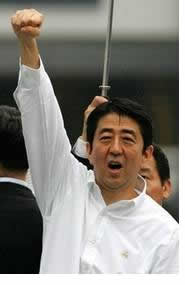 But as a political gift for Japanese prime-minister Shinzo Abe, the BoJ has delayed a long awaited quarter-point rate hike to 0.75%, until after the upcoming July 29 th ballot for the legislature's upper house. Abe is plummeting in the polls after losing three Cabinet ministers, and his inept handling of a pension scandal and allegations of political corruption.
But as a political gift for Japanese prime-minister Shinzo Abe, the BoJ has delayed a long awaited quarter-point rate hike to 0.75%, until after the upcoming July 29 th ballot for the legislature's upper house. Abe is plummeting in the polls after losing three Cabinet ministers, and his inept handling of a pension scandal and allegations of political corruption.
Electoral defeat would not immediately threaten the ruling LDP coalition's hold on power because it has a commanding majority in the lower house, but an embarrassing loss could prompt party leaders to boot Abe from office.
However, once the election is out of the way, the decks would be cleared for a baby-step BoJ rate hike to 0.75%, in August as widely predicted by futures traders in Tokyo and Singapore.
“To stand pat on monetary policy for a long period of time is not a prudent strategy, since the acceleration of economic activity may in the future come to require a large adjustment in the policy rate, causing unnecessary swings in economic activity and prices,” said BoJ member Kiyohiko Nishimura on July 3 rd . However, at a subsequent meeting on July 12, only BoJ member Atsushi Mizuno voted for a rate increase.
“ It is desirable for policy rates to naturally converge to levels that would help minimize destabilizing risks to the economy. Side effects of keeping low interest rates regardless of economic conditions could weaken the yen and may increase protectionism among Japan's trading partners. It could also cause distortions in global asset prices by speeding up capital outflows from Japan,” Mizuno warned.

Tokyo's financial warlords, working in a close coordination with the US Treasury's Plunge Protection Team (PPT), have been skillful in guiding the dollar higher for most of this year.
But Tokyo and the PPT were caught off guard by Iran's Ayatollah, when he demanded on July 14 th , that Japanese oil refiners pay for Iranian crude in yen, instead of US dollars, starting in September.
The Ayatollah wants to be paid in Euros and yen for Iran's $54 billion of annual oil exports. That's just a drop in the bucket in the $2.9 trillion per day foreign exchange market. But since Nippon Oil agreed to pay for Iranian oil imports in yen, the US dollar has tumbled by 3.5-yen to as low as 119.10-yen.
Japan imported about 323,000 barrels per day of crude oil from Iran last year, or about 11% of Japan's total oil imports, in 2006. The National Iranian Oil Company is also trying to avoid a possible seizure of its assets by the US government amid tensions over its nuclear weapons program. China buys 15% of Iran's oil exports and has been paying in Euros since December. The Ayatollah's advisers might be skilful foreign currency traders, turning bearish on the dollar at 122.50-yen.
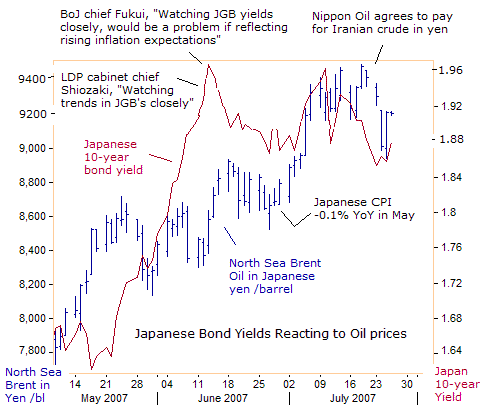
At the June 15 th BoJ meeting, some members noted a recent 0.25% rise in 10-year JGB yields to 2%, saying it was important to find out whether it was due to a favorable view on the economy or higher inflation expectations. Bank of Japan chief Toshihiko Fukui said the central bank needs to keep a close eye on recent rises in long-term rates and how they could affect Japan's economic outlook.
“The recent movements in long-term rates are a relatively new phenomenon so we need to watch them closely. It would be very problematic if the rise in bond yields signaled that market players are cautious about rising inflationary expectations,” he said. Yet that's exactly what's happening, with crude oil hitting a record 9,400-yen per barrel in Tokyo. Would Japan's financial warlords permit a stronger yen to keep oil and raw material import costs from exploding higher?

Perhaps the dollar /yen exchange rate is simply catching up with the greenback's big losses against every other currency around the globe. The US$ has been tracking the slide in the riskiest segment of the US sub-prime mortgage market, the ABX, BBB-, fell to just 39 cents on the dollar, and could lead to big losses for US banks and brokerage firms, and tighten lending standards in the housing market. With a glut unsold US homes at 8.8 months, and homebuilder sentiment at its lowest since January 1991, the US dollar has been on the skids all year.
With the Dollar Index teetering on the key psychological 80-level, the US Treasury's Plunge Protection Team sprung into action on July 23, with “Jawboning” exercises. “There has been a very significant housing correction. I think we're at or near a bottom there,” US Treasury chief Henry Paulson said on CNBC. “I don't deny there's a problem with sub-prime mortgages but it's quite containable. The economy is very, very healthy, despite the problems in the sub-prime mortgage lending sector.”
On July 20 th St Louis Fed chief William Poole, tried to brainwash his audience, with a “Don't worry, be Happy” speech. “The US sub-prime mortgage problems probably have a ways to go, but unless the pressure becomes much more severe, the problems would not impact consumer spending or credit quality more generally.”
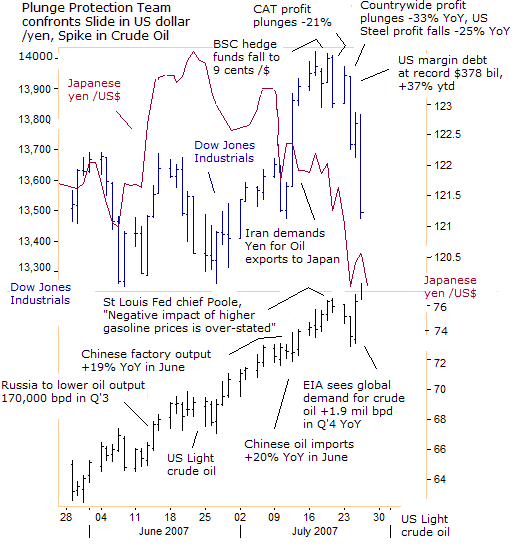
But three days later, on July 23 rd , the Dow Jones Industrials lost 236-points, partly due to the unwinding of “yen carry” trades and a slew of disappointing earnings from Caterpillar, American Express, Home Depot, Countrywide Financial, USG, US Steel, among others, in a market priced for perfection. On July 25 th , US PPT chief Paulson was hosting a conference on US corporate taxation, while the dollar was skidding towards 119-yen, and the Dow Jones Industrials were plunging 320-points lower in a panic towards the 13,460 area.
Harvard University Professor Martin Feldstein told the audience that “as long as the American dollar is greatly overvalued relative to other currencies, it's going to be hard for American products to get their share in other markets,” perhaps referring to the manipulated Chinese yuan and Japanese yen. “Marty, I'm a strong dollar man,” Paulson replied, fearing the possibility of a brutal unwinding of “yen carry” trades, and the blow-up of the PPT's Ponzi schemes arranged with Beijing and Tokyo.
But what about the surge in crude oil prices to $77 per barrel, up 20% from just two months ago? Should the markets be worried about the spiraling cost of energy that could sap household disposable income and crimp business profits?
In his speech on July 24 th St Louis Fed chief William Poole tried to brainwash the public with a sense of complacency. “There are certainly strains from the high price of energy, however, there is no energy crisis and households and firms are adjusting in a sensible way to price increases. Oil price increases over the past several years are, in percentage terms, roughly comparable to the 1970's episodes, but overall inflation has remained relatively contained.”
“The impact has been real, but the magnitude is small enough that prices increases have not disrupted the normal processes of economic growth. In my judgment, markets will continue to handle energy problems well and the future for the US economy is bright. Recent attention paid to the negative impact of higher gasoline prices on the consumer energy prices has been overstated,” Poole argued.
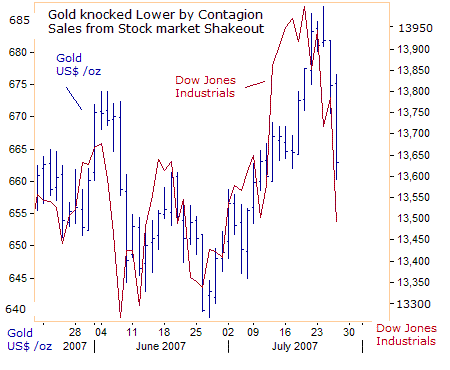
Is gold a safe haven from the brutal stock market shakeout? The US M3 money supply is expanding at a 13% annualized rate, its fastest in 30-years, the US dollar is plunging to its lowest levels in decades, and crude oil prices are soaring to record highs. Most logical folks would probably agree these signals are forecasting higher inflation, and bullish for gold, irrespective of the Fed's contortionism.
But we have seen this movie before, and during previous periods of panic stricken sell-offs in stock markets, gold has been swept lower by the contagion. If the Dow Jones Industrials are starting to price in a US economic recession however, then gold should outperform the DJI-30 index, no matter which way the markets move.
Under Paulson's tenure at the US Treasury, stock market bulls have always been able to rely on their “Plunge Protection Insurance” policies, to rescue their portfolios from nasty corrections. But as the stock markets climb to higher and higher levels, the cost of the Plunge Protection Insurance premiums is also going higher, as mushrooming money supply growth guarantees greater volatility in the markets.
But the story gets more interesting by the day. The Global Money Trends newsletter is your best investment, to track global commodity, currency, and bond and stock markets, with commentary and analy sis that is not found in the mainstream media. Of course, each edition contains a lot of cool charts, and is published on Friday's, with special alerts when unexpected events unfold.
This article is just the Tip of the Iceberg, of what's available in the Global Money Trends newsletter!
By Gary Dorsch,
Editor, Global Money Trends newsletter
http://www.sirchartsalot.com
Insightful analysis and predictions for the (1) top dozen stock markets around the world, Exchange Traded Funds, and US home-builder indexes (2) Commodities such as crude oil, copper, gold, silver, the DJ Commodity Index, and gold mining and oil company indexes (3) Foreign currencies such as, the Australian dollar, British pound, Euro, Japanese yen, and Canadian dollar (4) Libor interest rates, global bond markets and central bank monetary policies, (5) Central banker "Jawboning" and Intervention techniques that move markets.
GMT filters important news and information into (1) bullet-point, easy to understand analysis, (2) featuring "Inter-Market Technical Analysis" that visually displays the dynamic inter-relationships between foreign currencies, commodities, interest rates and the stock markets from a dozen key countries around the world. Also included are (3) charts of key economic statistics of foreign countries that move markets.
A subscription to Global Money Trends is offered at only $150 US dollars per year for “44 weekly issues”, including access to all back issues. Click on the following hyperlink, to order now, http://www.sirchartsalot.com/newsletters.php Call toll free from USA to order, Sunday thru Thursday, 2 am to 4 pm EST, at 866-576-7872.
Mr Dorsch worked on the trading floor of the Chicago Mercantile Exchange for nine years as the chief Financial Futures Analyst for three clearing firms, Oppenheimer Rouse Futures Inc, GH Miller and Company, and a commodity fund at the LNS Financial Group.
As a transactional broker for Charles Schwab's Global Investment Services department, Mr Dorsch handled thousands of customer trades in 45 stock exchanges around the world, including Australia, Canada, Japan, Hong Kong, the Euro zone, London, Toronto, South Africa, Mexico, and New Zealand, and Canadian oil trusts, ADR's and Exchange Traded Funds.
He wrote a weekly newsletter from 2000 thru September 2005 called, "Foreign Currency Trends" for Charles Schwab's Global Investment department, featuring inter-market technical analysis, to understand the dynamic inter-relationships between the foreign exchange, global bond and stock markets, and key industrial commodities.
Copyright © 2005-2007 SirChartsAlot, Inc. All rights reserved.
Disclaimer: SirChartsAlot.com's analysis and insights are based upon data gathered by it from various sources believed to be reliable, complete and accurate. However, no guarantee is made by SirChartsAlot.com as to the reliability, completeness and accuracy of the data so analyzed. SirChartsAlot.com is in the business of gathering information, analyzing it and disseminating the analysis for informational and educational purposes only. SirChartsAlot.com attempts to analyze trends, not make recommendations. All statements and expressions are the opinion of SirChartsAlot.com and are not meant to be investment advice or solicitation or recommendation to establish market positions. Our opinions are subject to change without notice. SirChartsAlot.com strongly advises readers to conduct thorough research relevant to decisions and verify facts from various independent sources.
© 2005-2022 http://www.MarketOracle.co.uk - The Market Oracle is a FREE Daily Financial Markets Analysis & Forecasting online publication.



